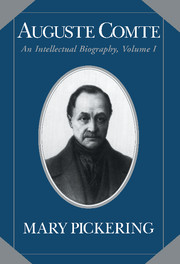Book contents
- Frontmatter
- Contents
- Acknowledgments
- Abbreviations
- Introduction
- 1 The Early Years
- 2 The Life and Works of Saint-Simon up to 1817
- 3 Comte's First Works for Saint-Simon
- 4 Comte's Growing Independence, 1819–1821
- 5 The Fundamental Opuscule and Comte's Rupture with Saint-Simon
- 6 The Aftermath of the Rupture: The Search for Connections
- 7 Comte's Efforts to Establish Himself
- 8 Intellectual and Mental Crises
- 9 The Road to Recovery, 1828–1830
- 10 Years of Success and Confrontation, 1830–1838
- 11 Comte's Changing Psyche and Aberrant Behavior, 1838–1840
- 12 The Encounter between Two Luminaries: Comte and Mill
- 13 1842: A Turning Point
- 14 Cours de philosophie positive: Positivism and the Natural Sciences
- 15 Cours de philosophie positive: Sociology
- Conclusion
- Bibliography
- Index
6 - The Aftermath of the Rupture: The Search for Connections
Published online by Cambridge University Press: 06 January 2010
- Frontmatter
- Contents
- Acknowledgments
- Abbreviations
- Introduction
- 1 The Early Years
- 2 The Life and Works of Saint-Simon up to 1817
- 3 Comte's First Works for Saint-Simon
- 4 Comte's Growing Independence, 1819–1821
- 5 The Fundamental Opuscule and Comte's Rupture with Saint-Simon
- 6 The Aftermath of the Rupture: The Search for Connections
- 7 Comte's Efforts to Establish Himself
- 8 Intellectual and Mental Crises
- 9 The Road to Recovery, 1828–1830
- 10 Years of Success and Confrontation, 1830–1838
- 11 Comte's Changing Psyche and Aberrant Behavior, 1838–1840
- 12 The Encounter between Two Luminaries: Comte and Mill
- 13 1842: A Turning Point
- 14 Cours de philosophie positive: Positivism and the Natural Sciences
- 15 Cours de philosophie positive: Sociology
- Conclusion
- Bibliography
- Index
Summary
You are watching the number of your predecessors augment each day.
Gustave d'Eichthal to Comte, 1824THE RECEPTION OF THE FUNDAMENTAL OPUSCULE
When Comte left Saint-Simon, he felt an immediate sense of liberation. Eager as always to analyze and dramatize his own development, he called his “rupture” a “moral revolution.” He was proud that he had achieved the same sort of transformation within himself that he hoped to effect within humanity. Just as humanity would be able to proceed to the final stage of maturity after its moral revolution, Comte felt that he was about to enter his adulthood and age of glory, when his “intellectual existence” could develop in a “purer and more complete manner.” But he remained anxious about his intellectual debts and his unsettled and financially insecure existence. Therefore, from 1824 to 1828, he devoted himself to establishing his “perfect independence” from both Saint-Simon and his parents.
His first step was to distribute his hundred copies of the Plan des travaux nécessaires pour réorganiser la société, the ones without Saint-Simon's offensive introduction and extraneous title (Catéchisme des industriels). Worried, however, about damaging his reputation, he first angrily crossed out his own flattering foreword along with his references to being the “student of Saint-Simon.”
- Type
- Chapter
- Information
- Auguste ComteAn Intellectual Biography, pp. 245 - 314Publisher: Cambridge University PressPrint publication year: 1993
- 1
- Cited by

